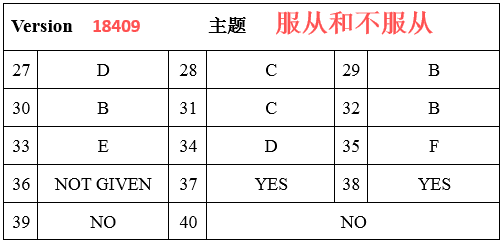很多考生对GRE阅读的文章来源有兴趣,纷纷猜测GRE阅读理解中的文章出处。不管怎么说,考生若是能够知道这些文章的出处对阅读备考会很有帮助。下面小编就和大家分享GRE阅读的文章是怎么来的,希望能够帮助到大家,来欣赏一下吧。
GRE阅读的文章是怎么来的?了解来源有助备考提分
GRE阅读文章来源介绍:搜集“源文章”
出题机构一般有自己固定的信息源和搜集信息的渠道。如ETS使用一个名为Source Finder的软件在Internet上自动检索数字论文库EBSCO中的文献,并从中提炼出符合各种考试风格要求(比如GRE和TOEFL等)的样本GRE阅读文章。
GRE阅读文章来源介绍:加工改写
出于版权限制,ETS用于实际的新GRE阅读考试的文章长度最多只能引用10%的原文长度。这种“带着镣铐跳舞”的结果是大量文章内容被改写,重写和删节。改写一般会大量使用分词及从句,使句子变得更紧凑、更严密。尽管改写后的文章会变得错综复杂,但出题机构会尽量保持文章中原有的鲜明态度以及较好的层次结构。如:文章一开始给出一个老观点,后来有人提出新观点,驳斥老观点,文章作者对这个新观点或完全同意、或持部分保留意见、或是做出有正有负的混合评价。
GRE阅读文章来源介绍:设置出题点
出题机构一般会先出关于文章主题、套路、态度、结构以及与文章的主题有关的问题,再针对文中比较明确的内容出题。在出题方式上求新求变,一般会将原文中出现的词汇或句子换一种说法表达出来。最后再找一些极易被考生忽略的细节作为出题对象,以此提高考试难度,拉开考生的分数。
GRE阅读文章来源介绍:题材广泛,不拘一格
如前言中所说,GRE阅读理解的文章所涉及的题材有所区别,即GRE考试阅读没有管理类的文章,而这正是新GRE阅读经常出现的题材。但总的来说,它们所涉及的题材都十分广泛。
一般来说,新GRE阅读文章可分为以下四类:人文类文章 (humanities), 自然科学类 (science), 社会科学类 (social science) 和商业管理类 (business)。
从新GRE阅读文章选择可以看出,尽管GRE考试阅读文章涉及的学科众多,对这些杂乱的学科无需具备相应的知识,答案的重点均可在文章中找到。尊重新GRE阅读文章的字句,不自己杜撰、屏蔽信息,这个就是可以做出完美GRE阅读理解的重点。
GRE阅读分数的影响因素
一、专业向阅读是软肋
有些同学做GRE阅读比较糟糕,原因是如果篇长阅读是社科类的,更准确地说是艺术类的。根据一般的经验,中国考生最害怕的就是社科类的长阅读。这种阅读再加几个生词,绝对能要你命。花了很多时间好好读了,结果还是不知所云,7题全蒙的。考完问了一下别人,情况也都差不多。
二、造成这种状况的原因
造成这种现象的原因,对于我来说,就是对美国文化了解太少。像这次那篇BT长阅读,说的好像是什么impressionist(印象派)和modernist(现实主义)的东东。由于对这方面毫无了解,所以读这篇文章毫无感觉。平心而论,哪怕再给我十分钟我也读不懂,所以我后来也索性放弃跨区了。
我不是要大家去补习美国文化的知识,这工程量太大,尤其对10月考试的同学。网上都说平时要多看什么economist什么的,试问有几个人会真正为了GRE去看?
三、给出的一些建议
我的建议就是,大家可以抽一点时间,利用相关资源(比如wikipedia),多去了解一下GRE社科类阅读爱考的知识。凭我粗粗做完所有阅读备考资料的印象,GRE社科类阅读非常喜欢考黑人文学Black literature,黑人音乐Black music(尤其是Jazz),妇女(包括妇女地位的改变,妇女文学),艺术类包括impressionist、modernist等。另外务必多留意一下上述知识的代表人物!比如Ragtime就是Jazz的代表人物及一种风格。并不是要求大家知道这个人物做了什么,只需要混个眼熟,考试的时候万一碰到一大串人名,能对其中一两个有点眼熟,能大概猜测出来是关于什么的就行!
GRE阅读:云和气候
As of the late 1980’s, neither theorists nor large-scale computer climate models could accurately predict whether cloud systems would help or hurt a warming globe. Some studies suggested that a four percent increase in stratocumulus clouds over the ocean could compensate for a doubling in atmospheric carbon dioxide, preventing a potentially disastrous planetwide temperature increase. On the other hand, an increase in cirrus clouds could increase global warming.
That clouds represented the weakest element in climate models was illustrated by a study of fourteen such models. Comparing climate forecasts for a world with double the current amount of carbon dioxide, researchers found that the models agreed quite well if clouds were not included. But when clouds were incorporated, a wide range of forecasts was produced. With such discrepancies plaguing the models, scientists could not easily predict how quickly the world’s climate would change, nor could they tell which regions would face dustier droughts or deadlier monsoons.
15.1. The author of the passage is primarily concerned with
(A) confirming a theory
(B) supporting a statement
(C) presenting new information
(D) predicting future discoveries
(E) reconciling discrepant findings
15.2. It can be inferred that one reason the fourteen models described in the passage failed to agree was that
(A) they failed to incorporate the most up-to-date information about the effect of clouds on climate
(B) they were based on faulty information about factors other than clouds that affect climate
(C) they were based on different assumptions about the overall effects of clouds on climate
(D) their originators disagreed about the kinds of forecasts the models should provide
(E) their originators disagreed about the factors other than clouds that should be included in the models
15.3. It can be inferred that the primary purpose of the models included in the study discussed in the second paragraph of the passage was to
(A) predict future changes in the world’s climate
(B) predict the effects of cloud systems on the world’s climate
(C) find a way to prevent a disastrous planetwide temperature increase
(D) assess the percentage of the Earth’s surface covered by cloud systems
(E) estimate by how much the amount of carbon dioxide in the Earth’s atmosphere will increase
15.4. The information in the passage suggests that scientists would have to answer which of the following questions in order to predict the effect of clouds on the warming of the globe?
(A) What kinds of cloud systems will form over the Earth?
(B) How can cloud systems be encouraged to form over the ocean?
(C) What are the causes of the projected planetwide temperature increase?
(D) What proportion of cloud systems are currently composed of cirrus of clouds?
(E) What proportion of the clouds in the atmosphere form over land masses?
GRE阅读相关文章:
★ GRE词汇如果高效的背诵记忆
★ GRE背单词记不住怎么办
★ GRE词汇考试常见词根词缀汇总
★ 心理学与生活读书心得1000字5篇
★ 夏令营特色活动策划方案
★ 说明文的范文800字,说明文的范文800字
★ GRE词汇易混淆内容整理
★ GRE词汇背诵谐音法
★ 2020GRE分类词汇最新整合
★ 如何能够更有效的背单词呢
GRE阅读文章来源介绍
上一篇:GRE备考积累阅读量怎么做
下一篇:返回列表





